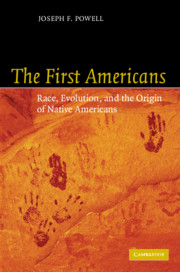Book contents
- Frontmatter
- Contents
- Acknowledgments
- Prologue: The Kennewick controversy
- PART I Race and variation
- PART II The Pleistocene peopling of the Americas
- 5 The Pleistocene and ice-age environments
- 6 Ancient cultures and migration to the Americas
- 7 Kennewick Man and his contemporaries
- 8 Human variation in the Pleistocene
- PART III The First Americans, race and evolution
- References
- Index
6 - Ancient cultures and migration to the Americas
Published online by Cambridge University Press: 21 August 2009
- Frontmatter
- Contents
- Acknowledgments
- Prologue: The Kennewick controversy
- PART I Race and variation
- PART II The Pleistocene peopling of the Americas
- 5 The Pleistocene and ice-age environments
- 6 Ancient cultures and migration to the Americas
- 7 Kennewick Man and his contemporaries
- 8 Human variation in the Pleistocene
- PART III The First Americans, race and evolution
- References
- Index
Summary
PLEISTOCENE CULTURES IN THE AMERICAS
Back in the old days, say about three years ago, we had a pretty compelling scenario for the peopling of the Americas. We believed the first Americans came out of northeast Asia during the latest Pleistocene, crossing the Bering land bridge into Alaska during a period of lowered sea level. For a time the massive North American ice sheets blocked their way south, but after the Laurentide and Cordilleran glaciers melted, back say 12,000 years ago, a group or groups of these hunters sped south through the newly opened “Ice-Free” Corridor between them (Wright, 1991). Once they reached the unglaciated lower 48 states, they radiated out across the length and breadth of North America with what appears to be archaeologically breathtaking speed (e.g. Haynes, 1964, 1992).
(Meltzer (2001: 27))Clovis first?
Anthropologists David Meltzer (2001) and Nina Jablonski (2002) have noted that our view of the peopling of the Americas is moving away from the traditional “Clovis-first” view described in the above quotation. Significant changes in our understanding of Paleoindian archaeology have occurred in the past few decades, with old ideas challenged by new theories and data. We now know that humans have occupied the New World for at least the past 11,000 to 12,000 yr BP (Meltzer, 2001). As Meltzer (1993b, 2001) and others (Dixon, 1999; Powell and Neves, 1998, 1999; Wright, 1991) have remarked, the colonization of the New World seems to be an unbelievable feat of hunter-foragers traveling thousands of miles south from Beringia in “blitzkrieg” waves of advance, with their descendants arriving in Tierra del Fuego, South America, in a mere 500 to 600 years.
- Type
- Chapter
- Information
- The First AmericansRace, Evolution and the Origin of Native Americans, pp. 114 - 127Publisher: Cambridge University PressPrint publication year: 2005

